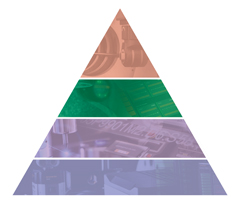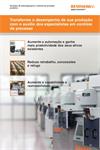Controle em processo
O controle ativo do processo permite a usinagem de peças corretas "já na primeira vez".
A camada controle durante o processo do Processo Produtivo Pyramid™ possui controles incorporados ao processo de usinagem. Estes controles ativos respondem automaticamente às condições do material, variações inerentes ao processo e eventos não planejados para minimizar a não conformidade do processo.
Mantenha o controle durante a usinagem

A camada controle durante o processo do Pyramid trata das fontes de variação inerentes à usinagem, tais como desgaste de ferramentas e variações de temperatura, proporcionando feedback inteligente para o processo à medida que a usinagem progride.
Estes são controles ativos aplicados durante a usinagem das peças.
A medição durante o processo permite
- que a usinagem se ajuste às variações no processo, tais como deformação da peça, deflexão da ferramenta e efeitos térmicos
- Atualização dos sistemas de coordenadas, parâmetros, desvios e fluxo lógico do programa, dependendo das condições reais do material
A detecção de ferramenta quebrada reconhece
- a presença de uma ferramenta
- a posição da ferramenta – para assegurar que a ferramenta não foi arrancada
- arestas de corte quebradas e/ou lascadas
Controles ativos
O controle ativo de processo permite que as peças sejam produzidas corretamente já na primeira vez, assim a capacidade não é utilizada para retrabalhos e correções.
A medição automática em processo faz com que suas máquinas não precisem mais esperar os operadores para que sejam reiniciadas.
A medição durante a produção fornece a inteligência necessária para que suas máquinas-ferramenta tomem decisões por si mesmas, possibilitando a usinagem “sem operadores” por períodos prolongados, aumentando a sua produtividade.
Os apalpadores de inspeção de peças, o sistema de detecção de ferramenta TRS2 e o software Productivity+™ adaptam as operações de usinagem às condições reais de material e ambiente através de feedback automatizado.
Documentos
-
 Folheto: Soluções de metrologia para o controle do processo produtivo
Folheto: Soluções de metrologia para o controle do processo produtivo
Transforme o desempenho de sua produção com o auxílio dos especialistas em controle de processo
